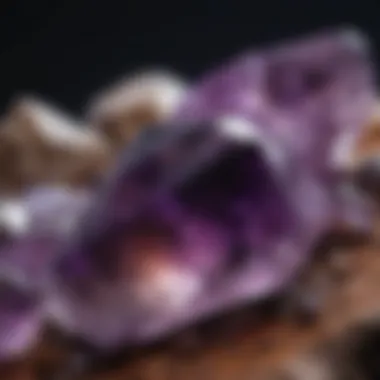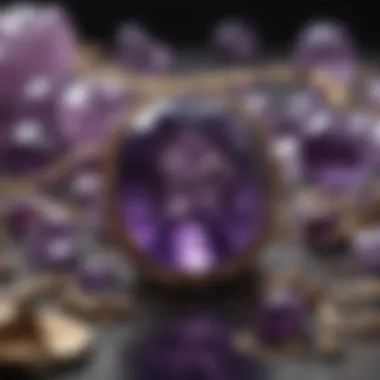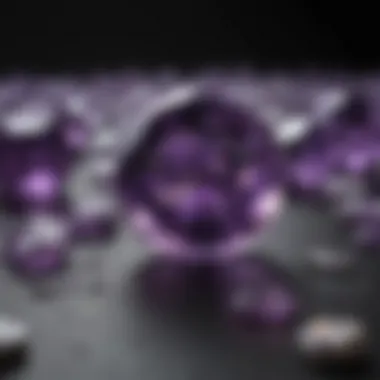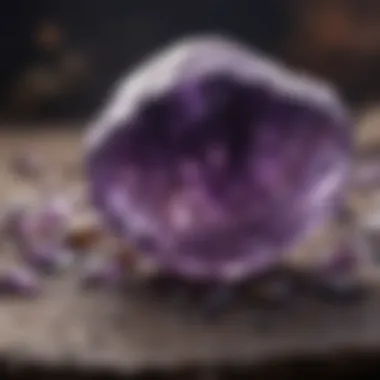Analyzing Amethyst Costs: Factors and Insights


Intro
Amethyst, often hailed as the purple jewel of the earth, is more than just a pretty stone. Its appeal spans through time, culture, and even mythical beliefs—making it an intriguing subject for collectors and enthusiasts alike. In this comprehensive guide, we’ll peel back the layers surrounding the costs associated with amethyst. Understanding what influences its price can help you make informed decisions, whether you're eyeing a piece for your collection, considering an investment, or simply fascinated by this gemstone.
In this article, we will explore several dimensions of amethyst pricing, from its historical significance to practical tips for evaluating its value. You'll gain insights into the market dynamics that dictate how much you might expect to pay for this captivating stone and how it stacks up against other gemstones.
Topic Overview
Definition of amethyst
At its core, amethyst is a variety of quartz known for its stunning violet hues, which can range from pale lavender to deep purple. This gemstone gets its color primarily from iron impurities and natural radiation. Not only is its appearance striking, but amethyst has earned a place in cultural lore, often associated with tranquility, protection, and justice, making it a beloved choice in jewelry and home decor.
Brief history and significance
Historically, amethyst was considered a luxurious stone, adored by royalty and influential figures. In ancient Greece, it was believed that the gemstone could prevent intoxication, leading to its name derived from the Greek word amethystos, meaning "not drunk." Throughout the ages, it has adorned crowns and rings and has been regarded as a protective talisman. The significance of amethyst has deep roots in various cultures and continues to capture the imaginations of those who appreciate its beauty and lore.
Identification and Classification
How to categorize amethyst
Understanding how amethyst is classified can be pivotal when evaluating its cost. While many think of it merely as purple quartz, the reality is far more nuanced. The categorization can be based on:
- Color Saturation: The deeper and more vivid the purple, the higher the value.
- Clarity: Clear stones without inclusions are valued higher than cloudy ones.
- Origin: Different regions, such as Brazil or Zambia, can influence price due to availability and perceived quality.
- Cut: The quality of the cut can enhance the beauty and market value.
Tips for identifying key features
When examining amethyst for purchase or collection, here are some key features to look for:
- Transparency: Gaze through the stone; higher clarity means better value.
- Inclusiveness: Check for any minerals or gas bubbles inside; fewer inclusions suggest higher quality.
- Color Uniformity: A consistent hue across the stone is usually desired.
"When it comes to amethyst, the eye is the best judge. Remember, what may catch one person's fancy may not do the same for another."
Amethyst’s complexities in price derive from not just its aesthetic qualities but its historical narrative, making it a fascinating choice for collectors. Understanding these facets will enhance your ability to navigate the market and appreciate the craftsmanship behind this beautiful gemstone.
Prelims to Amethyst
Amethyst, a captivating violet variety of quartz, holds not just beauty but a significant place in jewel history. Understanding this gemstone isn't merely about its aesthetic appeal; it's central to grasping the myriad factors that dictate its cost. For collectors and enthusiasts alike, there's much to uncover beneath the surface of this stunning stone.
Defining Amethyst
Amethyst is a semi-precious stone that captivates many with its rich purple hue. The color can range from a light lavender to a deep violet, depending on the presence of iron and the amount of radiation the crystal has absorbed. This variation in color influences its desirability and price, as deeper tones are typically seen as more valuable. What sets amethyst apart is not just its color but its crystalline structure, which forms in geodes and rock cavities, giving it a unique character.
Historical Significance
The roots of amethyst run deep, tracing back thousands of years. In ancient times, this stone was cherished by Egyptian pharaohs, who believed it possessed protective properties. Greek mythology also intertwined with amethyst, where it was associated with Bacchus, the god of wine. Legends suggested that wearing the stone could prevent intoxication; hence, it was often found in goblets used for drinking.
Over the centuries, amethyst has oscillated in popularity. During the Middle Ages, it became highly sought after by both clergy and royalty; in fact, it was considered a cardinal gemstone alongside diamonds and emeralds. One might say amethyst was regarded as a “noble” stone by many cultures. These historical associations contribute to its enduring value in the modern market.
Among modern collectors, awareness of its historical value often plays an important role in appreciation. As they sift through pieces in gem shows or online marketplaces, knowing the rich background of amethyst deepens their connection to the stone itself.
Factors Influencing Amethyst Pricing
Understanding what drives the price of amethyst involves dissecting various elements that play a role in its value. Amethyst is not merely a gemstone; it's a narrative woven from factors like color, clarity, cut, and historical context. Yarned into its fabric is demand, market trends, and the intricacies of where the stones are sourced from. Grasping these influences is vital for collectors and users who want to make informed decisions.
Color Variations
Color is perhaps the most striking element when evaluating amethyst. It can be the difference between a precious jewel and an overlooked stone.
Depth of Color


The depth of color in an amethyst can either sing its praises or mellow its appeal. Generally, the richer the purple, the higher the price. A deep, vibrant purple amethyst, almost resembling royalty in its hue, tends to catch the eye of collectors and gem enthusiasts alike. This depth adds not just beauty but an aura of rarity.
In this context, a gem that showcases a well-saturated, even color, rated as the highest quality by gemologists, is widely sought after. However, it’s important to note that deeper color doesn’t always win the day; some buyers prefer lighter shades for their unique charm.
- Key Highlight: A vibrant purple elevates desirability.
- Unique Feature: Variations in saturation meaningfully affect pricing.
Overall, the depth of color is beneficial choice for this analysis as it guides both aesthetic preference and market valuation.
Color Zones
On the flip side, we have color zones, which reveal another layer of complexity in pricing amethyst. These zones refer to the presence of varying shades within a single stone, showcasing swirls or bands that might transition from light lavender to deep purple. These distinct contrasts can make a piece more visually intriguing, a characteristic that some collectors might avidly seek.
Although many would argue that a solid color is ideal, certain buyers might prize these color zones for their uniqueness. However, the presence of color zoning can be a double-edged sword: while some might admire its diversity, others might view it as a flaw, which could influence the overall desirability.
- Key Highlight: Color zones add individuality to the gemstone.
- Unique Feature: Some collectors embrace these variations, while others see them unfavorably.
Thus, understanding color zones is essential for accurate pricing as they help determine a stone's individuality in the competitive market.
Clarity and Inclusions
Clarity also plays a massive role in the valuation of amethyst. Stones with fewer inclusions usually hold greater worth because they exude a sense of purity and rarity. Inclusions are like fingerprints or birthmarks of stones; they tell a story, but in many cases, the less visible they are, the better. Amethyst can sometimes exhibit internal flaws, which may negatively impact its marketability.
Cut and Shape
The cut of the amethyst refers to how it’s shaped and polished, fundamentally altering how light interacts with it. A well-cut stone can enhance its natural beauty, making colors pop and encouraging a sparkle that’s hard to resist.
Common Cuts
Common cuts of amethyst, such as round, oval, and emerald, have garnered popularity mainly for their aesthetic appeal. Round cuts tend to emphasize the stone's color and brilliance, while oval cuts can appear larger than they actually are, giving the illusion of greater value.
However, choosing a cut is subjective. Some may prefer unique shapes, but it's crucial to consider their market desirability.
- Key Highlight: A well-crafted cut significantly boosts visual allure.
- Unique Feature: Different cuts cater to diverse consumer preferences.
Therefore, the evaluation of common cuts is imperative as it directly impacts the stone's appeal and pricing.
Impact of Craftsmanship
The impact of craftsmanship during the shaping process is equally noteworthy, as it speaks volumes about the overall quality of the piece. A skilled craftsman can elevate the mundane to exquisite through their expertise, ensuring that every facet reflects light beautifully. Additionally, a meticulous cut often results in a higher demand, thereby raising the price point.
- Key Highlight: Quality craftsmanship can transform an average stone into a desirable gem.
- Unique Feature: Attention to detail in craftsmanship can significantly add to the stone's value.
Overall, recognizing the impact of craftsmanship is vital as it can decisively influence pricing and desirability.
Market Trends and Valuation
Understanding the market trends and valuation of amethyst is paramount for both collectors and enthusiasts. This segment unpicks the layers that contribute to the real-time value of this alluring stone. It’s not just about how shiny or purple a piece is; a variety of forces drive the prices up or down in today’s market. In this section, we’ll examine key elements like global pricing trends and the intricate supply chain dynamics that impact what you pay when you decide to take home a piece of amethyst.
Global Pricing Trends
The global pricing trends of amethyst offer valuable insights not just into the stone itself, but also into the economic conditions affecting its supply and demand. Prices can fluctuate based on various factors such as:
- Market Demand: If the public's appetite for amethyst increases, so does its price. This is typically seen during jewelry fashion weeks or gemstone expos, where interest spikes.
- Quality Variations: Not all amethysts are created equal; those exhibiting deeper color or fewer inclusions tend to command higher prices, impacting averages.
- Geopolitical Factors: If a key sourcing region faces political instability or regulations change, this can throw a wrench in the availability of the stone.
Monitoring these trends is crucial. For instance, during recent years, there has been a notable increase in interest surrounding ethically sourced gemstones. If a particular mining operation gains a reputation for sustainable practices, amethysts from that source may experience a price boost regardless of their inherent quality.
To illustrate: According to industry reports, the average cost of fine quality amethyst has risen by approximately 20% in the past five years due to heightened demand.
Supply Chain Dynamics


The supply chain dynamics frame how amethyst moves from mine to market, unveiling the hidden processes that can influence pricing. A smooth supply chain can keep costs down, while disruptions can raise them dramatically. Important considerations include:
- Mining Locations: Countries like Brazil and Uruguay have established reputations for high-quality amethyst. Events or regulations affecting these regions can sway availability all over the globe.
- Transportation Costs: Logistical hurdles, such as shipping delays or rising fuel costs, can also affect pricing. Amethyst might be available, but if it takes months to ship, expect costs to ascend.
- Market Saturation Presence: If too many gemstones flood the market, the price could plummet. Conversely, if higher-quality stones become rarer, their prices will rise as collectors fight to get them.
By understanding this complex web, collectors can make informed decisions. Recognizing that a premium price may also mean a more convoluted journey through the supply chain can lead to deeper insights into the valuation of a piece.
"Recent trends show an increasing shift towards sustainable practices in gemstone mining, affecting both supply and consumer preference."
Amethyst vs Other Gemstones
When considering the landscape of gemstones, amethyst holds a particularly esteemed position, celebrated not only for its stunning purple hues but also for its historical and perceived metaphysical properties. The comparison with other gemstones, such as lavender quartz and various popular choices, sheds light on the nuances of market demand, pricing strategies, and consumer preferences. By honing in on how amethyst stacks up against its competitors, we can glean insights into its unique place in both the aesthetic and commercial fields.
Comparative Pricing Analysis
Amethyst vs Lavender Quartz
Amethyst and lavender quartz frequently find themselves in the same discussions due to their color similarities. Both exhibit delicate purples, but amethyst typically boasts a deeper and richer saturation. This key characteristic serves as a significant factor in their pricing differences. Amethyst, especially in darker tones, tends to draw higher prices, reflecting both its rarity and popularity among collectors.
The primary unique feature of lavender quartz lies in its generally lighter and softer lavender shades, often attributed to its more widespread availability. This leads to lower prices in comparison to amethyst. For collectors, deciding between the two may hinge on aesthetic preference and value perception. Amethyst is often viewed as more premium, allowing it to hold its value over time, while lavender quartz may provide a more budget-friendly entry point into the world of colored gemstones.
Amethyst vs Other Popular Gemstones
When broadening the scope to include other popular gemstones, such as sapphire or emerald, amethyst continues to distinguish itself. The most evident difference lies in price range: sapphires or emeralds often command much higher prices because of their desirability and the quality associated with top grades. Amethyst, on the other hand, provides a stunning visual appeal with a significantly more accessible price tag.
The unique advantage that amethyst offers over some other gemstones is its combination of beauty and affordability, making it an attractive choice for many collectors, especially those who are just starting out. Moreover, amethyst is also more readily available than some gemstones, further entrenching its position in the market. However, with increasing demand, its price points could change, making it essential for collectors to monitor market trends closely.
Market Demand Comparisons
As we analyze the market demand for amethyst compared to other gemstones, it's clear that several factors drive buyer interest. For one, the cultural significance of amethyst, historically linked to royalty and spirituality, gives it an unparalleled allure. Furthermore, the growing trend toward wellness and natural healing seems to enhance its appeal, especially among a demographic that values the supposed metaphysical properties of stones.
Factors contributing to demand include consumer education about the stone's origins and treatments, impacts of social media on marketing gems, and shifting aesthetic preferences within jewelry trends. Buyers increasingly seek unique pieces that tell a story, and amethyst fits this requirement, possibly even more so than its competitors, as its rich history and vibrant color evoke strong emotions and connections.
Ultimately, while amethyst and its competitors each have their places in the market, the gemstone continues to shine brightly amid fierce competition. With fluctuating trends and consistent adaptations within the gemstone marketplace, understanding these dynamics can enhance a collector's decision-making process.
"The beauty of amethyst lies not just in its color, but in the stories that surround it.
Regional Pricing Variations
Understanding regional pricing variations is crucial in grasping the broader picture of amethyst's cost. The global jewelry market doesn't operate in a vacuum; factors like locale, local laws, availability, and mining practices heavily shape the pricing landscape. For collectors and buyers alike, recognizing these nuances can lead to more informed decisions.
These regional differences can influence a buyer's budget significantly. For instance, amethyst sourced from certain regions may carry a premium due to its esteemed quality or historical relevance.
Sourcing Regions and Their Impact
Brazil
Brazil is often hailed as a powerhouse in the world of amethyst production. Known for its rich deposits, it supplies a significant portion of the global market. The deep purple hue of Brazilian amethyst, often regarded as of the highest quality, sets a benchmark in pricing. Its quality is underpinned by the area’s volcanic soil, allowing for that signature coloration which is just delightful. However, even premium stones can vary in cost, influenced by market demand and seasonal availability.
One caveat to consider, though; the accessibility of Brazilian mines has prompted some environmental concerns, and this might affect future supply. Still, for collectors, the allure of Brazilian amethyst is hard to resist due to its prevalent market presence and robust distribution channels.
Uruguay
While Brazil may dominate in quantity, Uruguay shines when it comes to quality and uniqueness. The amethyst mined here often boasts an exceptional depth of color, further enhanced by the quality of local craftsmanship.
Uruguayan amethyst tends to carry a higher price tag because it is less common. Its unique geological formation allows for larger crystals, which are often favored by collectors. The distinct deep violet tones coupled with excellent clarity provide an irresistible draw for buyers seeking premium stones. However, these exquisite qualities come at a price, making them less accessible for the budget-conscious.
Africa
On the African continent, regions such as Zambia and South Africa contribute notably to the amethyst market. Zambian amethyst, for example, is becoming increasingly popular due to its darker shades of purple and affordability compared to its Brazilian counterparts. The mining practices are evolving here, leading to fresh finds that appeal to collectors favoring unique coloration.


Another point of consideration is the mining labor conditions, which might encourage buyers to choose ethically sourced stones that could impact costs. Overall, African amethyst, with its diverse range of colors and competitive pricing, presents a valuable alternative for collectors on the lookout for both diversity and value.
Import and Export Influences
The dynamics of import and export play a significant role in shaping amethyst pricing. Factors like tariffs, trade agreements and shipping costs affect how amethyst is priced once it hits the market. In addition, fluctuations in demand across different regions can lead to sudden price spikes or drops, making it essential for collectors to keep abreast of current market trends to navigate their purchases wisely.
Assessing Amethyst Value
When it comes to purchasing amethyst, understanding its value is paramount. Many factors play into the valuation of this exquisite gemstone, and grasping these elements helps buyers make informed choices. This can be pivotal, especially for collectors and enthusiasts who aim to invest wisely in their collections.
Evaluating Quality
Expert Standards
Expert standards play a crucial role in determining the quality of amethyst. Professionals in the gemology field often assess stones based on color, clarity, cut, and carat weight — a framework known widely as the 4 Cs.
- Color: The most desired hues fall within the deep purple spectrum, often complemented by secondary hues of red or blue. Lighter shades might not hold as much value, but there are exceptions, especially if they are particularly rare.
- Clarity: This involves examining the presence of inclusions; the fewer inclusions present, the higher the value. Experts look through the stone carefully, sometimes using tools like a loupe.
Choosing these standards provides buyers with a reliable method to gauge the authenticity and value of amethyst. However, it’s important to note that expert evaluations may come with a fee, which needs budget consideration.
Personal Judgment
While expert standards can guide assessments, personal judgment is an equally important consideration. How does a collector feel about the stone? Does it resonate with them? Personal evaluation often includes subjective elements that cannot be quantified by mere measurements.
- Emotional Connection: Many collectors choose stones based on personal sentiment. A piece can invoke nostalgia or represent a significant life event, which may lead to a willingness to invest more than the market suggests.
- Aesthetic Preference: Individual taste can greatly influence the perceived value. A unique, one-of-a-kind piece may be worth more to someone seeking out an interesting specimen, irrespective of the general market trends.
This subjective approach means that some may find themselves willing to pay a premium for stones that speak to them, regardless of standard valuation methods.
Buying Guide for Collectors
When it comes to acquiring amethyst, knowing where to look and what to ask is essential for getting the best deal.
Where to Buy
Understanding where to buy amethyst can greatly impact your overall cost and quality. Different vendors can offer varying prices based on market dynamics, overhead, and sourcing methods.
- Local Jewelers: Establishing relationships with local jewelers can yield advantages. They often handpick their inventory, ensuring quality and authenticity. However, they may charge a premium for craftsmanship and customer service.
- Online Marketplaces: Websites like eBay or Etsy can present good opportunities for bargains, but they come with risks of authenticity and quality. Researching sellers and checking customer reviews can mitigate some of this risk.
Identifying reliable sources before making a purchase can help prevent costly mistakes.
Questions to Ask Sellers
Before closing any deals, asking the right questions can uncover valuable information about the stones on offer. These inquiries can lead to a deeper understanding of the product and boost buyer confidence.
- Origin of the Stone: Knowing where the amethyst comes from can inform you about its value. For instance, stones from Brazil might differ from those sourced from Uruguay in terms of clarity and color.
- Certification: Inquire whether the amethyst is accompanied by certification from a recognized authority or gemologist. A certified piece often holds more value and adds an extra layer of authenticity.
Getting answers to these questions not only equips buyers with information but can also signal the seller's expertise and professionalism in the field.
Culmination
Understanding the intricate dynamics surrounding the cost of amethyst is crucial for those invested in the world of gemstones, particularly for collectors and enthusiasts. This section synthesizes observations from various previous parts of the article, providing clarity on several key elements.
Summary of Insights
Insights gathered throughout this analysis highlight the multifaceted nature of amethyst pricing. First, color variations significantly influence value. The depth and uniformity of purple hue, as well as the presence of color zoning, can lead to stark contrasts in pricing. For instance, a pristine, deep purple stone may fetch a far higher price than a paler or unevenly colored piece.
Additionally, clarity stands as another determining factor. Stones with minimal inclusions are generally more desirable. Buyers often scrutinize these inclusions as they can tell a story about the gem's journey from mine to market. Craftsmanship also plays a pivotal role; well-cut diamonds not only sparkle brilliantly but can also highlight the color and clarity of the amethyst, augmenting its overall appeal.
On a broader scale, we explored global pricing trends and the impact of supply chain dynamics. Influences from different sourcing regions, such as Brazil and Uruguay, have their unique footprint on pricing. The shifting demand in emerging markets has also redefined what collectors can expect to pay for amethyst today, standing as testimony to the fluctuating nature of this gemstone's value.
Future Market Predictions
Peering into the future, several indicators suggest trends that may shape the amethyst market. As sustainability and ethical sourcing gain traction among consumers, the demand for responsibly mined gemstones is likely to rise. Collectors and investors might increasingly opt for amethysts sourced from regions known for their ethical standards.
Further, the diversification of amethyst-related products, including jewelry and alternative wellness applications, may contribute to a broader appreciation of the stone, potentially driving prices upward. We may also witness a surge in interest due to social media influences, where unique pieces gain visibility and desirability.
To conclude, the price of amethyst is not merely a reflection of its physical attributes but also a tapestry woven from historical significance, market trends, and emerging consumer preferences. Those looking to invest wisely in amethyst will benefit from staying informed, adapting to market shifts, and understanding how quality intersects with market demand.



